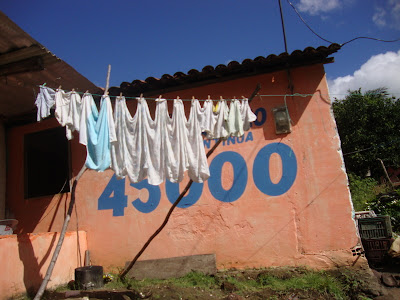 We took a day trip with Mary’s aunt, uncle, and cousin
(Rosangela, Mario, and Camila) to the island of Itamaraca. Itamaraca comes from the indigenous language and means something
like “singing rock” or "stone that sings." We noticed the word maraca in it, and made some
connections, although we didn’t actually see any singing or shaking rocks. We did see some
singing people, inside more colonial churches. Like Olinda, this was one of the
first settlements of the Portuguese in the XVI century. There aren’t nearly as many people here
now, but Itamaraca actually came first. The whole island started out as a
sugarcane plantation.
We took a day trip with Mary’s aunt, uncle, and cousin
(Rosangela, Mario, and Camila) to the island of Itamaraca. Itamaraca comes from the indigenous language and means something
like “singing rock” or "stone that sings." We noticed the word maraca in it, and made some
connections, although we didn’t actually see any singing or shaking rocks. We did see some
singing people, inside more colonial churches. Like Olinda, this was one of the
first settlements of the Portuguese in the XVI century. There aren’t nearly as many people here
now, but Itamaraca actually came first. The whole island started out as a
sugarcane plantation.
This was one of the biggest churches on the island, even
though it looks real small in this photo. We though the cross blocking out the
sun made for a cool photo.
Rosangela in front of a big blue door – this building was
another example of the colonial architecture that could be seen all over the
island.Mary loves her some painted tile, and was delighted to see
it everywhere. Patterns like these were typical and often covered entire homes.
More recent buildings still use tile, but without the awesome hand-paintedness.
The whites! Nick sometimes likes to take random photos of
laundry drying, and this particular clothesline seemed photogenic. It was
hanging in front of a house with the name of a local political candidate
painted on it.
Camila, Mary, Rosangela, and Mario standing in front of a
cliffside view. Behind... you guessed it, a church. Another of the oldest in
Brazil, though much more modest than the ones we saw in Olinda. Apparently the
Portuguese didn’t have the resources to cover everything in gold just yet...
But they still appreciated a good view!

These houses were in the small village near the church. Here the tiles and the political endorsements were hand-painted...

We came across this old cemetery in the jungle. It was charmingly decrepit, in classic old cemetery style. The burial chapel had been mostly lost to the elements, but some stone walls and crypts remained.
Here is the top of the tallest crypt peeking out from behind
the palm trees. Someone must have done something pretty awesome (or horrible –
it was a sugar plantation, after all) to get buried there.
Itamaraca at its finest.
Just before going to this beach we
stopped at a marine mammal conservation park, where we saw some baby manatees.
According to the informational movie we watched, Portuguese sailors first
thought they were mermaids because of their tails and the weeds that often got
caught on their heads. These sailors must have been at sea for way too long at
that point... We have chosen to protect the identities of these manatees by not
picturing them here.
We had a beer at this beach and went swimming. It was a bit
crowded with a bit too much litter, but the fine white sand and clear water
made up for it. Camila and Mary walked out on one of the many sandbars that ran
perpendicular to the beach shortly after this photo was taken.
































